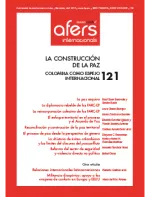Reconciliación y construcción de la paz territorial en Colombia

This paper analyses how the Nasa indigenous community of Toribío (Cauca, Colombia) has configured mental reconciliation models in spite of the violent feedback they received during the armed conflict in Colombia. For this analysis, the theoretical perspective of cognitive institutionalism is used. Empirical evidence was collected mainly through semi-structured interviews and focus groups. The results suggest that strategies of peaceful resistance, such as the creation of Permanent Assembly Sites, the Community Life Plan and the Indigenous Guard, have contributed to producing successful solutions in the search for reconciliation and peace in indigenous territories.
Key words:reconciliation, peace, armed conflict, indigenous Nasa people, Cauca, Colombia
DOI: doi.org/10.24241/rcai.2019.121.1.91
>> The full text articles of this issue are available only in Spanish language
How to cite this article: Catalina Acosta Oidor et al. «Reconciliación y construcción de la paz territorial: el caso de la comunidad nasa (Colombia)». Revista CIDOB d’Afers Internacionals, n.º 121 (abril de2019). DOI:doi.org/10.24241/rcai.2019.121.1.91
*Authors: Catalina Acosta Oidor, docente e investigadora, Universidad Santo Tomás (Colombia); Cristhian Uribe Mendoza, doctorando en Ciencia Política, Universidad Nacional Autónoma de México; Johanna Amaya Panche, doctoranda, Universidad de Essex (Reino Unido); Alexander Idrobo Velazco, docente, Universidad Santo Tomás; Felipe Aliaga Sáez, docente, Universidad Santo Tomás; Diego Alejandro Ballén Velásquez, aspirante a Magíster, Facultad Latinoamericana de Ciencias Sociales..